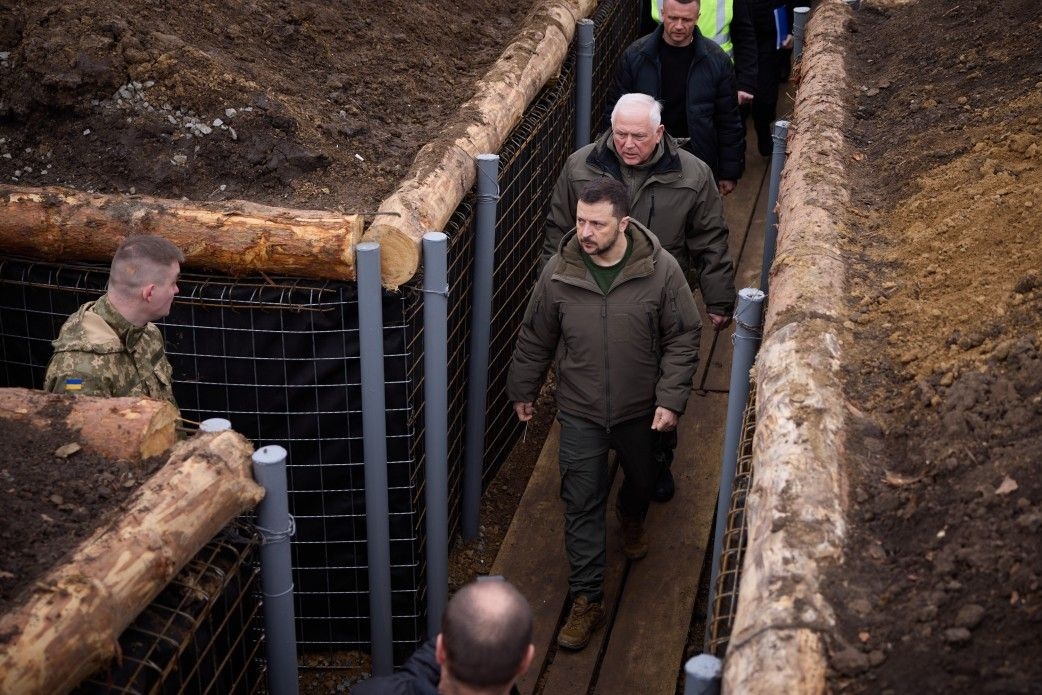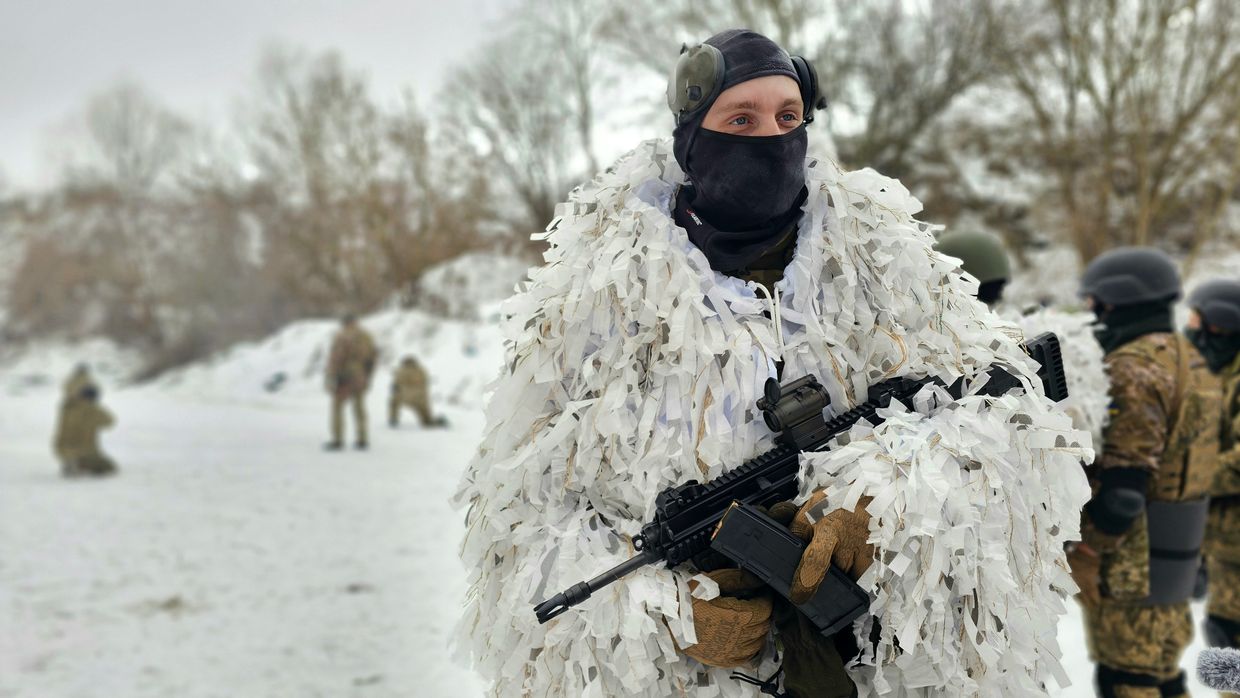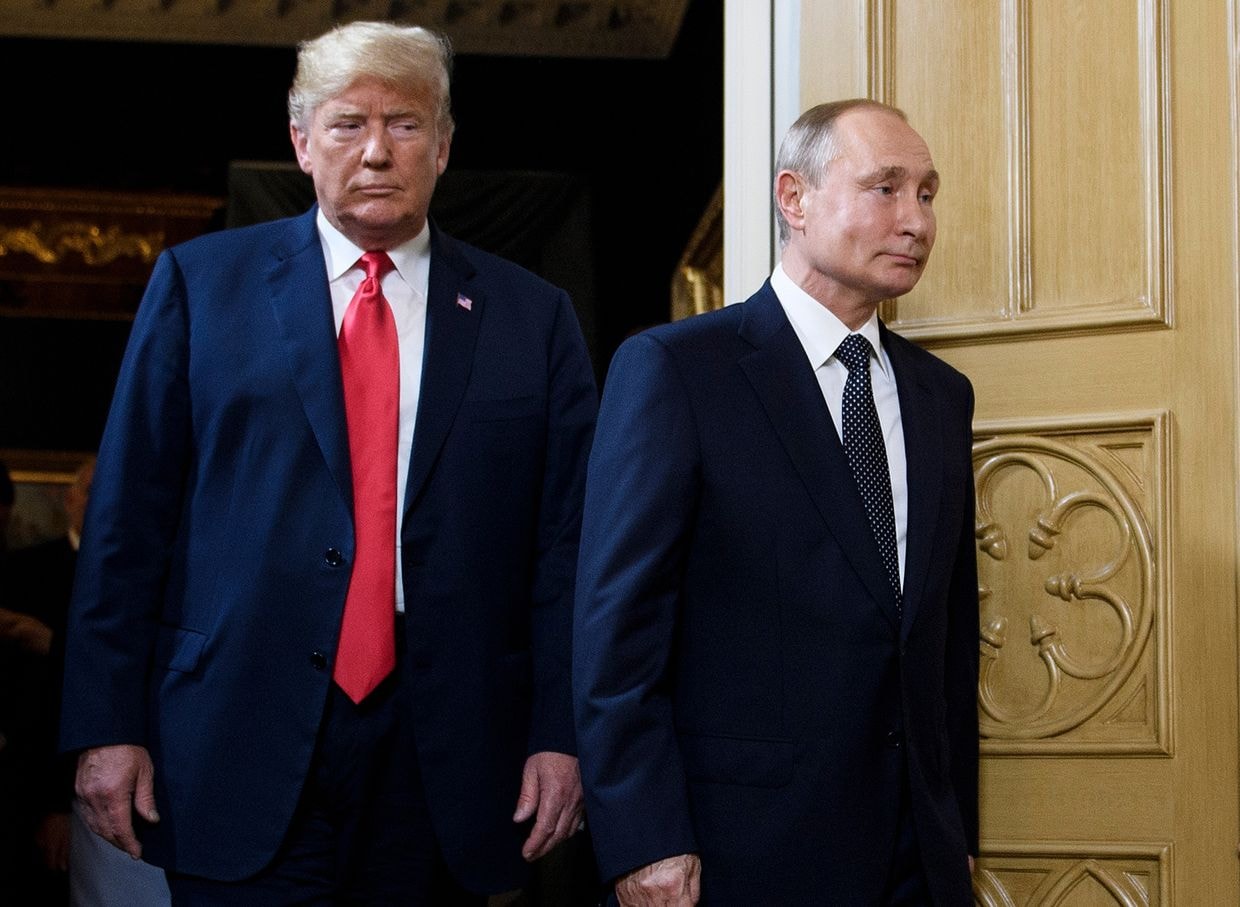
Sumy Oblast fortifies amid looming threat of Kharkiv attack
Representatives of the Regional Administration and the construction contractor Avtomagistral-pivden LLC inspect fortifications being built in the region in Sumy Oblast, Ukraine on March 16, 2024. (Kostiantyn Liberov/ Libkos/Getty Images)
SUMY OBLAST – A group of military officers, local police chiefs, border guards, emergency service workers, and farmers gather around a map of Sumy Oblast’s Myropillia community in an undisclosed location around a mile from Russia.
The air raid siren doesn’t interrupt the meeting, which is devoted to reinforcing a narrow three-mile strip of borderland in the northeastern region.
The military commander says he plans to plant more landmines and build additional fortifications, turning the strip into an impregnable fortress where no Russian troops or hardware can enter without suffering heavy casualties. He has a light dispute with the farmers, urging them to stop cultivating fields.
"We also need to keep the border secure from the farmers," the commander sarcastically quips at the meeting attended by the Kyiv Independent in late March, alluding to farmers who keep violating a ban on planting on fields the officials want to mine.
Sumy Oblast’s border areas have faced near-daily shelling and raids by Russian saboteurs since Moscow’s troops were pushed back across the border in April 2022.
But the situation has changed. In mid-March, Russia intensified its attacks on the area after anti-Kremlin militia fighting on Ukraine’s side carried out a series of raids into Russia’s western Belgorod and Kursk oblasts. Some villages caught in the crosshairs of the border volleys were left in ruins.
The raids were apparently part of a plan to thwart Russia’s designs for a new attack on Ukraine’s northeast, Andrii Yusov, Ukraine's military Intelligence agency spokesperson, told the Kyiv Independent without revealing any details as to what exactly Russia was after.
While Russia's attacks could have been a response to the raids, they may also be connected to a larger assault the Kremlin is allegedly planning on neighboring Kharkiv, Ukraine’s second-largest city.
Russian propagandists as well as Russian independent media outlets have recently said that Russian President Vladimir Putin could attempt a renewed assault against the city.

Military expert Mykhailo Samus believes that if Russia were to try to invade Kharkiv again, they could use attacks on neighboring Sumy Oblast as a way of disrupting the city’s defense.
If Putin were to try and move his troops into Sumy Oblast as well, he would certainly face defeat, military experts and officials told the Kyiv Independent. He doesn’t have the troop numbers or the hardware required to push through the heavily fortified area, they say.
But circulating reports of a wide-ranging assault make the situation on the northeastern border uncertain. Ukrainian soldiers stationed in Sumy Oblast along the 350-mile zigzag-shaped border remain vigilant, fortifying and heavily mining the area while closely watching any movement by Russia.
Watching the border
Small groups of Russian saboteurs occasionally cross the border and approach nearby observation posts undetected by slipping through tall fields of weeds. Several soldiers and civilians have been killed or captured as prisoners of war in such cross-border raids in Sumy Oblast.
"Saboteur groups shoot at anything they see," Yevhen Tkachenko, an officer with the 129th Territorial Defense Brigade, told the Kyiv Independent in the village of Myropillia that lies inside the 3-mile zone from the border.
The Russian border land locks the Myropillia community from three sides. Daily attacks with mortars, artillery, multiple rocket launchers (MLRS), first-person-view (FPV) drones, and guided bombs have damaged all the local infrastructure.
Explosions and assault rifle shootouts are heard in the distance. There are no shooting ranges in the area.

Roughly 20 miles southeast, Russian forces aren’t as confident, says Dmytro Zinchenko, a drone instructor with the 117th Territorial Defense Brigade, deployed in the Krasnopillia community.
His unit is tasked with protecting Ukraine from threats beyond its northern border.
From his position near the border, Zinchenko — a car repairman before the full-scale invasion in the regional capital of Sumy — watches Russian troops move carefully and covertly through entrenched concrete positions on their side of the border.
"The (Russians) felt much more confident a year ago. Everything is changing," Zinchenko told the Kyiv Independent standing near the rusty remnants of a Russian tank, destroyed at the beginning of the full-scale invasion.
Ukraine has deployed more troops and started using more drones in the area, he said.
At times, he scarcely registers the shifts in the daily Russian attacks, a grim routine that has become all too familiar after months of service monitoring the border, much like many other soldiers.

Meanwhile, the geography of the area complicates strikes against the Russian military. Zinchenko says the rugged terrain and branching rivers make it difficult to navigate first-person-view (FPV) drones.
“The terrain is crazy. We drop explosives (if it’s hard to attack with an FPV drone)," he said laughing.
Zinchenko says his unit has a steady supply of drones for targeting Russians. Yet he laments the need for engineers to meticulously inspect almost every new batch since the majority of drones are not ready for use straight after unpacking.
Unlike his fellow soldiers from the same brigade deployed to the eastern front lines where battles are raging, Zinchenko’s usual targets are the equipment Russian troops use to build fortifications and observation towers along the border.
“You won't watch beautiful footage (from) here of a drone hitting a Grad MLRS. (The Russians) don't bring military hardware that close," he said.
Building fortifications
“Dragon teeth” anti-tank concrete pyramids, ditches, trenches, dugouts with reinforced structures, firing positions, corrugated steel shelters, and their construction are visible in the fields just outside Sumy.
Tkachenko, an officer with the 129th Brigade, says this is the third defensive line.
Two weeks before visiting Sumy in late March, Zelensky announced that Ukraine was building 1,240 miles of fortifications worth $520 million across three lines of defense. He pledged to finish construction "in a few months."
The biggest chunk, over $38 million, is slated for Sumy Oblast.


Zelensky inspected the construction of these fortifications and visited positions of the 117th Brigade on March 27.
The Wall Street Journal reported in early March that the construction progress was not fast enough in anticipation of a Russian major offensive, which according to Zelensky, might come at the end of May or June.
The Financial Times then reported in mid-April, citing unnamed Ukrainian officials, that Russia might plan to attack Kharkiv as part of a wider offensive.
Northeastern Kharkiv Oblast neighbors Sumy Oblast while both sit on the Russian border. Downtown Kharkiv lies just 20 miles south of the nearest borderline.
While Russia’s military goals may vary, if Moscow orders its troops to march for Kharkiv, Sumy Oblast could be a part of their plan. Mykhailo Samus, director of the New Geopolitics Research Network, sees Sumy Oblast serving as a supportive foothold for the Russian troops in case the Kharkiv offensive emerges.
“(An operation in Sumy Oblast) means not the direction of the main attack but auxiliary strikes. They will have their own objectives, just like in February-March 2022,” Samus, a security and defense analyst with over a decade of military service, told the Kyiv Independent.
“Currently, the Russians don't have the capabilities (for the Kharkiv offensive). For now, it's just fantasies.”
Russia’s lack of manpower
Neither the Ukrainian military deployed near the Russian border nor analysts believe Russia has the capability to launch a new major offensive now.
The tactical situation in Sumy Oblast remains steady despite Russian saboteurs sneaking in and out, said Oleksiy Panasenko, call sign Beaver, a sergeant with the 117th Brigade.
Serving as a squad leader since the full-scale invasion began in February 2022, Beaver was among the first soldiers skirmishing with Russian forces riding long columns across his native Sumy Oblast.
The dynamic of the attacks on Ukraine’s northeast has increased but no Russian offensive activities or build-up have been observed across the border, he said. Though Beaver warns of vigilance.
"When they flatten certain areas, you have to expect something," he told the Kyiv Independent.
The next day after reelection, Putin repeated his intention to create a buffer zone — to keep Ukraine's offensive capabilities out of reach — along the Ukrainian border.
Putin’s pledge came amid anti-Kremlin militia raiding Russian border regions for days.
At the same time, Russian forces heavily showered Sumy Oblast’s border villages, including Velyka Pysarivka, with dozens of guided bombs among other weapons, prompting an evacuation.

Another soldier of the 117th Brigade, who goes by call sign Viking, said the border is under constant watch to prevent any breakthroughs amid escalation. As Viking speaks to the Kyiv independent, Russian artillery strikes hit an area nearby twice.
Viking spent months surveilling and reinforcing the first two defensive lines, dams, and roads along the extensive border strip within the three-mile zone assigned to his unit.
He doesn’t believe Russia can repeat its 2022 assault on the region even though he was the most magnanimous soldier the Kyiv Independent met in Sumy Oblast.
“Never underestimate the enemy. The enemy is powerful... But I think there won't be such breakthroughs as in the beginning. (If yes), we’ll push them back right from the outset,” Viking, who declined to provide his name due to security concerns, told the Kyiv Independent in a dark dugout in the Krasnopillia community.
Western officials neither believe that Russia has the capability to launch a new Kharkiv offensive without a major replenishment of its troops, Bloomberg reported on April 16.
"If they theoretically launch an operation in Kharkiv, they will need at least 300,000 troops. Impossible for them to gather (troops) discreetly now," Samus said, adding that intelligence will detect every move.
Russia is preparing to mobilize an additional 300,000 troops by June 1, Zelensky said days after Putin signed a decree in late March to conscript 150,000 Russians and Ukrainians under occupation in the spring draft.

With the current pace, Russia will need around a year to draft and train new troops to bolster its war effort. According to the U.K. Defense Ministry, Russia is likely recruiting 30,000 people monthly.
While Ukraine's military intelligence labeled the potential Kharkiv offensive as "a part of a Russian psyop," Zelensky said that Ukraine is monitoring all "Russia's disinformation and troops’ movement on the front line.”
"Today, Kharkiv is not in danger," Zelensky said, praising the city's defenses. "But Russians do not hide that (Kharkiv) is a desirable target."
Note from the author:
Hello, this is Alexander Khrebet, who brought you this field report from the border. I really appreciate you reading to the end of this article. Thank you! Being in Sumy Oblast was bittersweet. Mesmerizing nature with timber-covered hills and rivers flow through destroyed villages that have suffered Russian barrages and guided bombs. To keep reporting from areas like Sumy Oblast, where you can literally see Russia with the naked eye, the Kyiv Independent needs your support. By joining our community, you help us tell the world the truth about Russia’s war.












